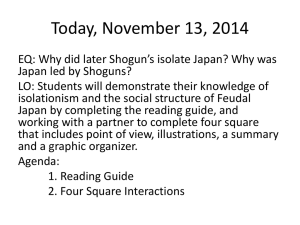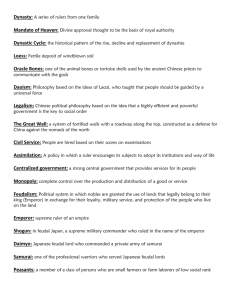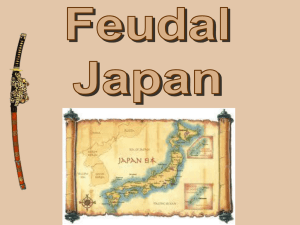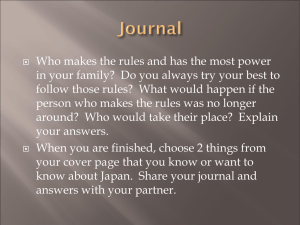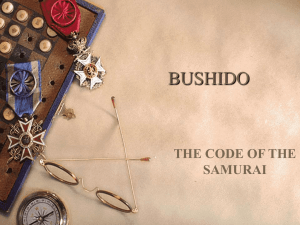Japanese vs. European Feudalism: A Comparison
advertisement
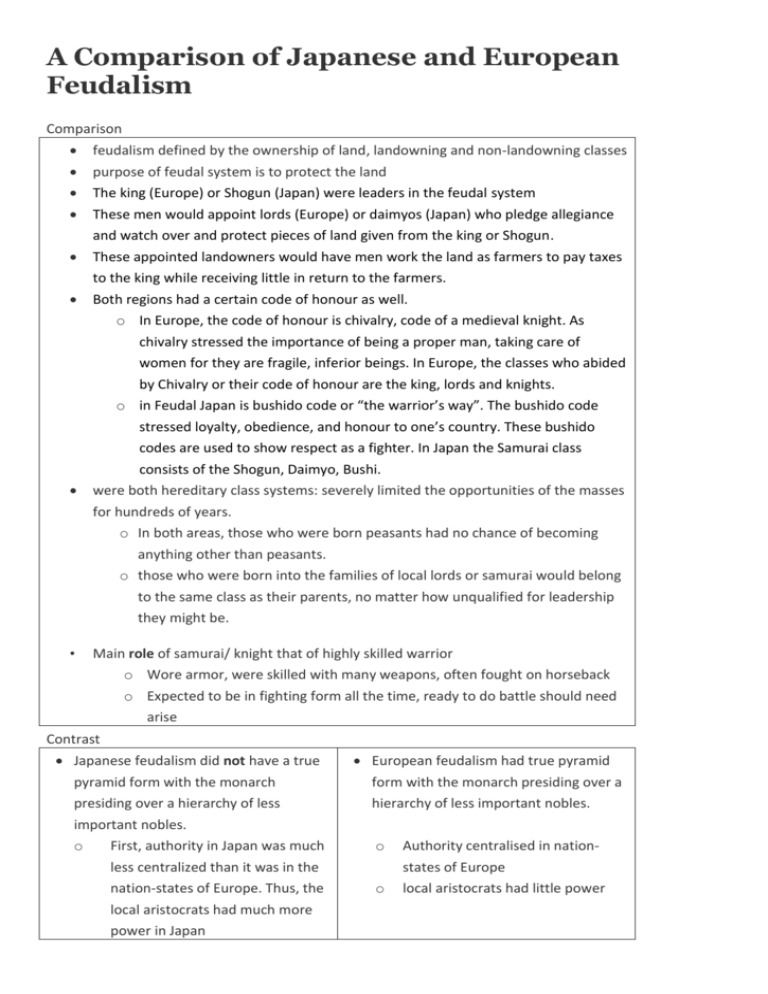
A Comparison of Japanese and European Feudalism Comparison feudalism defined by the ownership of land, landowning and non-landowning classes purpose of feudal system is to protect the land The king (Europe) or Shogun (Japan) were leaders in the feudal system These men would appoint lords (Europe) or daimyos (Japan) who pledge allegiance and watch over and protect pieces of land given from the king or Shogun. These appointed landowners would have men work the land as farmers to pay taxes to the king while receiving little in return to the farmers. Both regions had a certain code of honour as well. o In Europe, the code of honour is chivalry, code of a medieval knight. As chivalry stressed the importance of being a proper man, taking care of women for they are fragile, inferior beings. In Europe, the classes who abided by Chivalry or their code of honour are the king, lords and knights. o in Feudal Japan is bushido code or “the warrior’s way”. The bushido code stressed loyalty, obedience, and honour to one’s country. These bushido codes are used to show respect as a fighter. In Japan the Samurai class consists of the Shogun, Daimyo, Bushi. were both hereditary class systems: severely limited the opportunities of the masses for hundreds of years. o In both areas, those who were born peasants had no chance of becoming anything other than peasants. o those who were born into the families of local lords or samurai would belong to the same class as their parents, no matter how unqualified for leadership they might be. • Main role of samurai/ knight that of highly skilled warrior o Wore armor, were skilled with many weapons, often fought on horseback o Expected to be in fighting form all the time, ready to do battle should need arise Contrast Japanese feudalism did not have a true pyramid form with the monarch presiding over a hierarchy of less important nobles. o First, authority in Japan was much less centralized than it was in the nation-states of Europe. Thus, the local aristocrats had much more power in Japan European feudalism had true pyramid form with the monarch presiding over a hierarchy of less important nobles. o o Authority centralised in nationstates of Europe local aristocrats had little power o o o o o Secondly, although the lower nobility in Japan (the samurai) swore fealty to their local lords, the local lords did not give the samurai any land of their own. The samurai did not join a landowning hierarchy. Instead, they were given an independent income from their local lord based upon what that lord's lands produced. only most powerful samurai received land Most paid with food, usually rice Those given land did not work, live on land The samurai’s lands were worked by peasants, who gave the samurai money or food for payment each year. the European nobility received land in exchange for their military service, European knights usually had their own serfs to work the land the knights received from their lord. o While a Japanese samurai might have had servants, these servants did not work the land they way they would have done in Europe. Societal Privileges • Crowds parted to let them pass when samurai walked down street • People dropped eyes out of respect—and fear—because samurai had right to kill anyone who showed disrespect • Samurai followed strict code of ethics, known as Bushido, “the way of the warrior” • Bushido required samurai to be courageous, honorable, obedient, loyal • Word samurai means “those who serve;” each had to serve, obey his lord without hesitation, even if samurai, family suffered as result Discipline Chivalry” (courtesy, protecting serfs, loyalty to lord) o Justice o Loyalty o Defense o Courage o Faith o Humility o Nobility • Samurai who failed to obey, protect lord expected to commit seppuku— suicide by ritual disembowelment • • Strove to live disciplined lives Pursued activities requiring great focus, like writing poetry, arranging flowers, performing tea ceremonies Zen Buddhism • Many samurai accepted Zen Buddhism • Zen stressed discipline, meditation as ways to focus mind, gain wisdom Role of Women Both men, women of samurai families learned to fight • Usually only men went to war • Female samurai had to follow Bushido • Were prepared to die to protect home, family honor • Samurai women honored in Japanese society – Could inherit property – Allowed to participate in business Armour o Iron, leather, and silk held together with leather straps Sword, mace, bow and arrow, etc Armour o Chain mail (links,) heavy plates of steel Sword mainly; some bamboo guns What features defined Japan’s feudal warrior society? Samurai gave military service in exchange for property or payment; shoguns ruled in the name of the emperor; daimyo were powerful warlords. Rigid Feudal System Top of Society • Under Tokugawa rule, Japan’s strict feudal system more rigid • At top of society, emperor • Only a figurehead Shogun, Daimyo • Next was shogun, held real power as military ruler • Below shogun, daimyo—owed shogun loyalty Ruling Warrior Class • Under daimyo, samurai who served them • Emperor, shogun, daimyo, samurai made up ruling warrior class Three Lower Classes • Below ruling warrior class were three classes • Peasants, artisans, merchants Lower Classes Rules • Members of lower classes could not rise in social status • Could not serve in military or government, or hold government positions that might challenge power of warrior class Peasants • Peasants made up vast majority—about 80 percent—of Japan’s population • Forbidden to do anything but farming • Supported selves by growing rice, other crops on daimyo, samurai estates Honor and Some Status • In Japan, farming considered honorable trade • Peasants enjoyed relatively high status, just below samurai • However, peasants paid most of taxes, led hard lives Artisans and Merchants • Below peasants were artisans • Artisans often lived in castle towns; made goods like armor, swords • Merchants at bottom of society • Not honored because did not produce anything • Merchants often grew wealthy • Could use wealth to improve social position

